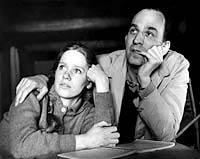
The death last week of Swedish filmmaker Ingmar Bergman brought to a close one of the most important chapters in film history. It didn’t matter very much whether or not you liked Bergman’s films; his name was synonymous with the idea of film as art. With the possible exception of the more flamboyant Federico Fellini, no filmmaker so completely embodied the idea of the foreign art film. It was a label that Bergman certainly deserved, but in some ways it did him a disservice, because it painted a rather grimly serious view of his work, giving it the taint of cinematic nasty medicine that’s good for you, and forcing a degree of reverence for his films that all but embalmed them. That’s a pity, because for all of Bergman’s introspective qualities, for all the weighty themes he explored in his films, and for all the large helpings of Lutheran guilt that tended to infuse so much of his work, neither the films themselves nor the filmmaker were dry and dull. On the contrary, the best of Bergman is alive in ways that lesser films only dream of.
Approaching Bergman as some kind of intellectual duty is not the way to go—something that his biggest fan Woody Allen understood when he made his brilliant Bergman parody Love and Death in 1975 (and something Allen seemed to forget when he made his own “Bergman movie,” Interiors, three years later). The true fan doesn’t worship; he loves the films—and he trusts the greatness of the films enough to be able to even make fun of them (and who knows them better?).
My own initiation into Bergman was hardly the stuff of reverence. When I was a teenager, a quasi-local TV station (you could get a picture if you twisted the antenna just so and held your breath) instituted something they boldly labeled “Adult Theater.” Well, who could resist that? It sounded very forbidden and risqué (and the occasional glimpse of a bare breast at 1 a.m. qualified in those days). In general, the films were certainly adult, but not quite in the way I had imagined—and a great number of them were Bergman movies. They were badly dubbed, true, but they were still Bergman movies. I came for the titillation, but I stayed for the art—even if I was way too young to understand the films. I was, however, aware that they were not your average fare.

I can’t say I was hooked at the time—that came years and years later (and has waxed and waned a few times) when I was able to better understand what I was seeing. I was, however, intrigued, and it never once occurred to me that I was being force-fed culture. I simply had no real idea who Ingmar Bergman was, and I think that’s probably the best way to approach his work if you’re not already familiar with it. Take the movies at face value and not as important classics. See for yourself that they’re not museum pieces, but vibrant works. Notice that even very serious offerings like The Seventh Seal (1957) and Wild Strawberries (1957) contain stretches of (sometimes broad) comedy.
Most of all, though, look at Bergman’s movies as movies—as the work of a man who was in the business of making movies, and who created a unified body of work in the process and not as some carefully calculated plan. How dull that would have been for Bergman! Imagine the stultifying sterility of not being able to look back at your work and be surprised by how it’s so much of a piece. And don’t stick just to the accepted classics, dip into the overlooked Bergman, too. Try out Dreams (1955) with its terrific roller-coaster scene and a great performance by Gunnar Björnstrand. Check out The Magician (1958), an often-overlooked work. Or what about the often-maligned The Devil’s Eye (1960) or the critically damned The Serpent’s Egg (1977).
The World Cinema series at Courtyard Gallery pays tribute to Bergman beginning this Friday with Wild Strawberries, and will feature a Bergman film every Friday over the next five weeks. It’s an excellent starting point, but don’t stop there. Go further and explore the depths of Bergman’s mysteries. You might be pleasantly surprised by how moving and entertaining the “art film” really can be.


Before you comment
The comments section is here to provide a platform for civil dialogue on the issues we face together as a local community. Xpress is committed to offering this platform for all voices, but when the tone of the discussion gets nasty or strays off topic, we believe many people choose not to participate. Xpress editors are determined to moderate comments to ensure a constructive interchange is maintained. All comments judged not to be in keeping with the spirit of civil discourse will be removed and repeat violators will be banned. See here for our terms of service. Thank you for being part of this effort to promote respectful discussion.